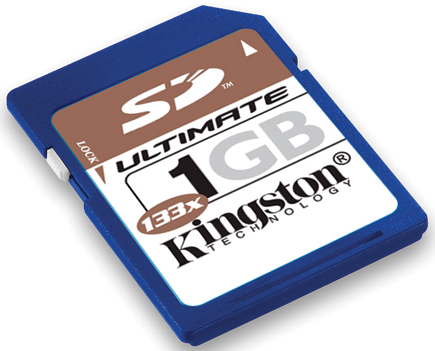Roundup: Memory Cards And Data Transfer Accessories; How Fast Are Those Fast CompactFlash And SD Cards?
As digital SLRs and "prosumer" digicams have become increasingly popular, the need for recording speed has also increased. Anyone who owns a 6- to 10-megapixel camera can really benefit from a very fast memory card. Particularly after shooting a series of images, recording time can be quite short--instead of frustratingly long--so the camera can be ready to shoot another burst in a few seconds. That's why we're seeing more frequent announcements about faster and faster memory cards, especially in the CF (CompactFlash) and SD (Secure Digital) formats.
 |
 |
There's a second benefit to high-speed media: quicker data transfer
when downloading to a computer. That aspect is most valuable after shooting
numerous photos, particularly large TIFF or raw format files. After you return
from shooting a sports event or a long day of travel photography, an ultra-fast
card lets you "dump" the image files quickly. Naturally, that also
requires a high-speed memory card reader; look for a review of those accessories
in a coming issue of Shutterbug.
While researching the issue of fast memory cards, I found that there are high-speed
media and lightning-fast media. Typically, it's difficult to determine
which falls into which category simply from reading the ads, and sometimes,
even from reviewing the specifications. That's why we decided to ask several
manufacturers to provide samples of their high-performance products for practical
testing. Some companies did not respond, but ATP, Delkin, Kingston, Lexar, Panasonic,
and SanDisk sent a variety of cards; these included the very latest, some still
top secret at the time of testing. If you're ready to trade up to the
latest, greatest products, some of these may certainly be of interest.
 |
How Fast Are They?
Memory cards are becoming incredibly fast, with some of the latest models boasting
write (recording) speeds of 80x, 100x, and now, even 133x. These ratings are
based on a standard where 1x equals the transfer of a mere 150KB of data per
second. Hence, 10x refers to a data transmission rate of 1.5 megabytes per second
(MB/s), while 133x denotes that nearly 20MB of data can be moved per second.
(Some manufacturers also publish specific MB/s data.) These ratings usually
refer to peak (maximum) data transmission rates when a card is used in a camera
with exceptionally fast data recording capability.
Note: Not every digicam can take advantage of a high-speed
memory card.
Unless a camera includes high-speed recording capability, there's no benefit
to using a very fast memory card. Many compact, affordable digicams, for example,
cannot take advantage of cards faster than about 10x. However, the current digital
SLRs and many of the latest high-resolution prosumer models were designed with
an optimized interface. These cameras are suitable
candidates for a 40x or faster card. If you're not sure about your own
camera's technology, check the Owners Manual or the manufacturer's
website for information.
 |
How We Tested
These tests are based upon real-world simulations that you and other photographers
would encounter. My practical testing method used a specific camera, computer,
and memory card reader. Because CF and SD cards are the most common types used
by high-end cameras, I decided to restrict this review to those two formats.
My plan was to determine several aspects of card speed. How quickly could each
card record numerous high-resolution JPEGs while used in a camera? Then, how
long would it take to transfer a massive amount of data from a card to a computer
using a high-speed USB 2.0 memory card reader? And how long would it take to
copy the same amount of data from a card to the computer's hard drive?
Finally, for comparison purposes, how much faster are the new products vs. "older"
cards?
For in-camera testing, I selected a 16-megapixel Canon EOS-1Ds Mark II because
it accepts both CF and SD cards. For consistency, I shot a burst of 23 full
resolution (Large) JPEGs of exactly the same scene with each of the cards. The
compressed images totaled approximately 180MB of data. Using a stopwatch, I
was able to determine the exact time taken by the camera to record the JPEGs
to each card. The timing started after I had shot the last frame and ended when
the camera's "recording" light was extinguished.
 |
For an assessment of data transfer speed to a computer, I selected a group
of JPEG and NEF (raw) format images made previously while I was testing the
Nikon D50. That's a popular digital SLR with 6-megapixel resolution, about
average for cameras of this type. The amount of data totaled 0.95GB for high-capacity
cards and 0.475GB for lower capacity cards. First, I transferred the data from
a PC to each card using the Delkin All-in-1 USB 2.0 card reader, an "average"
performer in the high-speed category. Subsequently, I copied the data from each
card to the computer, using the same card reader.
The computer used was a Compaq Pentium 4 2.8GHz laptop with a 4200 RPM hard
drive, USB 2.0 ports, 512MB of RAM, and Windows XP Home OS. Again, I consider
this PC to be "average" in speed and RAM memory. It was easy to
time both of the processes with a stopwatch. The resulting times are provided
in the CompactFlash and SD Card Performance charts.
































